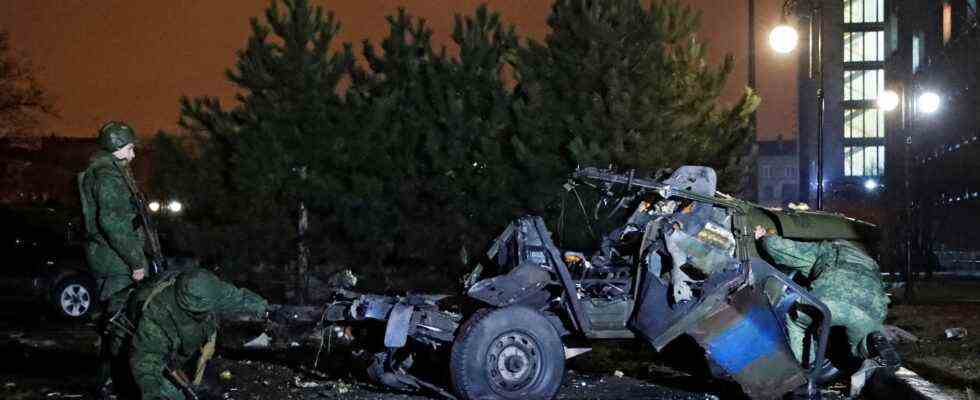fact finder
Status: 02/21/2022 1:59 p.m
Russian media reports about an alleged Kiev spy and attacks in the separatist areas. But so-called OSINT research suggests that not everything is as it seems.
Russian media reported at the weekend on a successful investigation in eastern Ukraine: a spy working for the government in Kiev was arrested on February 17. The man is said to have worked in the customs department of the “Donetsk People’s Republic” – and to have spied for Ukraine in the separatist areas.
He is suspected of being involved in the explosion of the car of the head of the “Donetsk People’s Militia”, Denis Sinenkov, reports Russian media such as Sputnik News Agency further. In addition, the alleged spy is said to have monitored leading ministers in Donetsk and ensured free crossing of the border for goods “necessary” for Kiev. He also revealed plans for how the government in Kiev intends to conquer the separatist areas. Bomb attacks on train stations and bridges are planned, for which the agent is said to have recruited potential perpetrators.
The case is cited by the Russian side as evidence that the government in Ukraine is escalating the situation and is planning an offensive. In the self-proclaimed Donetsk People’s Republic, separatist leader Denis Pushilin called all men to arms to fight Ukrainian government forces. Ukraine has repeatedly stressed that it is not planning an offensive against the separatists. Pushilin, in turn, spoke of massive shelling from the Ukrainian side.
Russia-Ukraine conflict: reports of new incidents
2/20/2022 12:03 p.m
plausibility questions
The reports on the situation in eastern Ukraine and the arrest of the alleged spy can hardly be independently verified. It is questionable, however, why an alleged spy who is said to be working for the government in Kiev in the separatist areas should have been initiated into the military leadership’s plans of attack. The risk of exposure and thus the plans becoming known seems at least considerable.
The timing also seems implausible, because the alleged spy was arrested on Thursday, according to Russian media reports, but the attack on the vehicle of the pro-Russian militia chief is said to have taken place on Friday. Russian media published an interview with the alleged spy on Saturday.
Questions about the pictures of the attack
There are also inconsistencies about the alleged attack in which the spy is said to be involved. The pro-Russian separatists published pictures of a vehicle said to belong to the militia chief that had been destroyed by an explosive device. This vehicle is parked in an empty parking lot, the license plate can be seen in the photos.
OSINT research on the exploded vehicle.
Image: twitter
However, OSINT researchers identified this number plate on another vehicle, an SUV. The assumption: The license plate was attached to another vehicle, the explosion staged. However, that is not proven.
Russian agents identified
OSINT is an acronym for Open Source Intelligence; What is meant here is the acquisition of information from freely available, open sources. This can include photo databases, social networks, telephone directories, hacked data on the web or maps such as Google Maps and many more. There is an overview of dozens of OSINT instruments online – these are offered in collections sorted by category.
With such OSINT research, it was possible, for example, to identify Russian secret service officers who are said to have carried out the Skripal attack in Great Britain. After this exposure, the two agents appeared as a couple in Russian media, claiming that they were in the UK for tourist reasons.
OSINT research is now firmly part of journalistic research. A BR/WDR-Team also used such instruments to follow leads from Russian hacking groups to the FSB secret service.
Metadata raises more questions
An important part of OSINT research is the verification of images and videos. Among other things, the metadata is analyzed in order to draw conclusions about the date of origin, for example. Here, too, there are currently unanswered questions regarding the situation in eastern Ukraine. A video released on February 18, in which the separatists announced an evacuation from the areas, is said to have been produced on February 16. The United States had expected Russian troops to attack Ukraine that day.
Further abnormalities result from the analysis of another video that, according to the Russian media, is said to show an act of sabotage. According to OSINT research, there are anomalies in the soundtrack, which is apparently older than the video itself.
However, meta data can also be manipulated, so that OSINT research can only ever give hints and must be compared with further information. The Bellingcat research platform in particular has caused a stir with various OSINT searches in recent years.
Again and again disinformation
The Russian side has worked with questionable claims and misleading images in various conflicts. For example, after war crimes in Syria, the shooting down of flight MH17 by pro-Russian separatists, the poisoning of ex-spy Skripal or the Tiergarten murder.
NATO and Western politicians warn of “false flag” operations and fear that Russia is creating an excuse for itself to invade Ukraine. At a press conference with Chancellor Olaf Scholz, Russian President Vladimir Putin again spoke of an alleged “genocide” in eastern Ukraine. The Russian state broadcaster RT is now reporting that the separatists have asked Russia for military help because of the situation in the Donbass.

